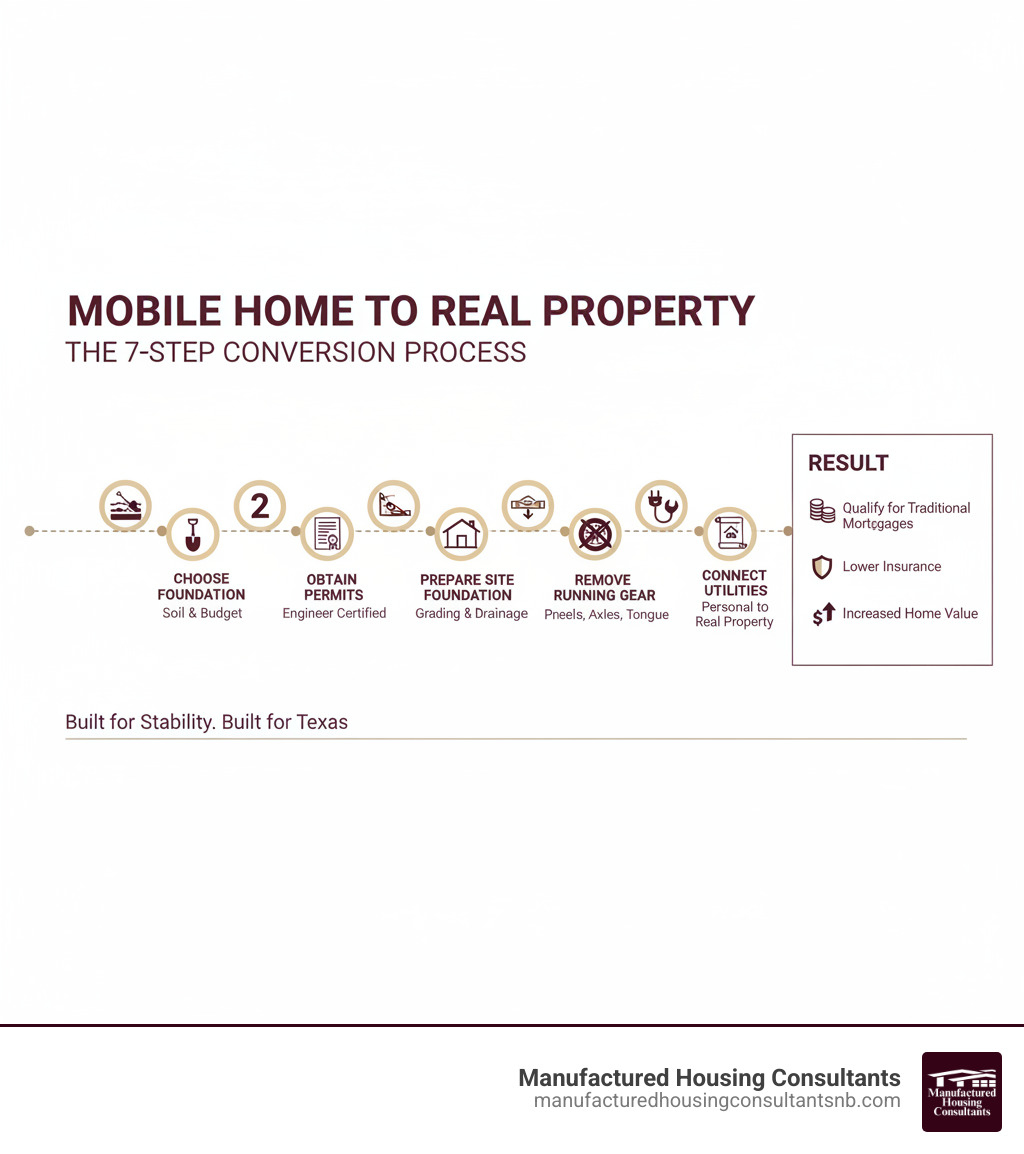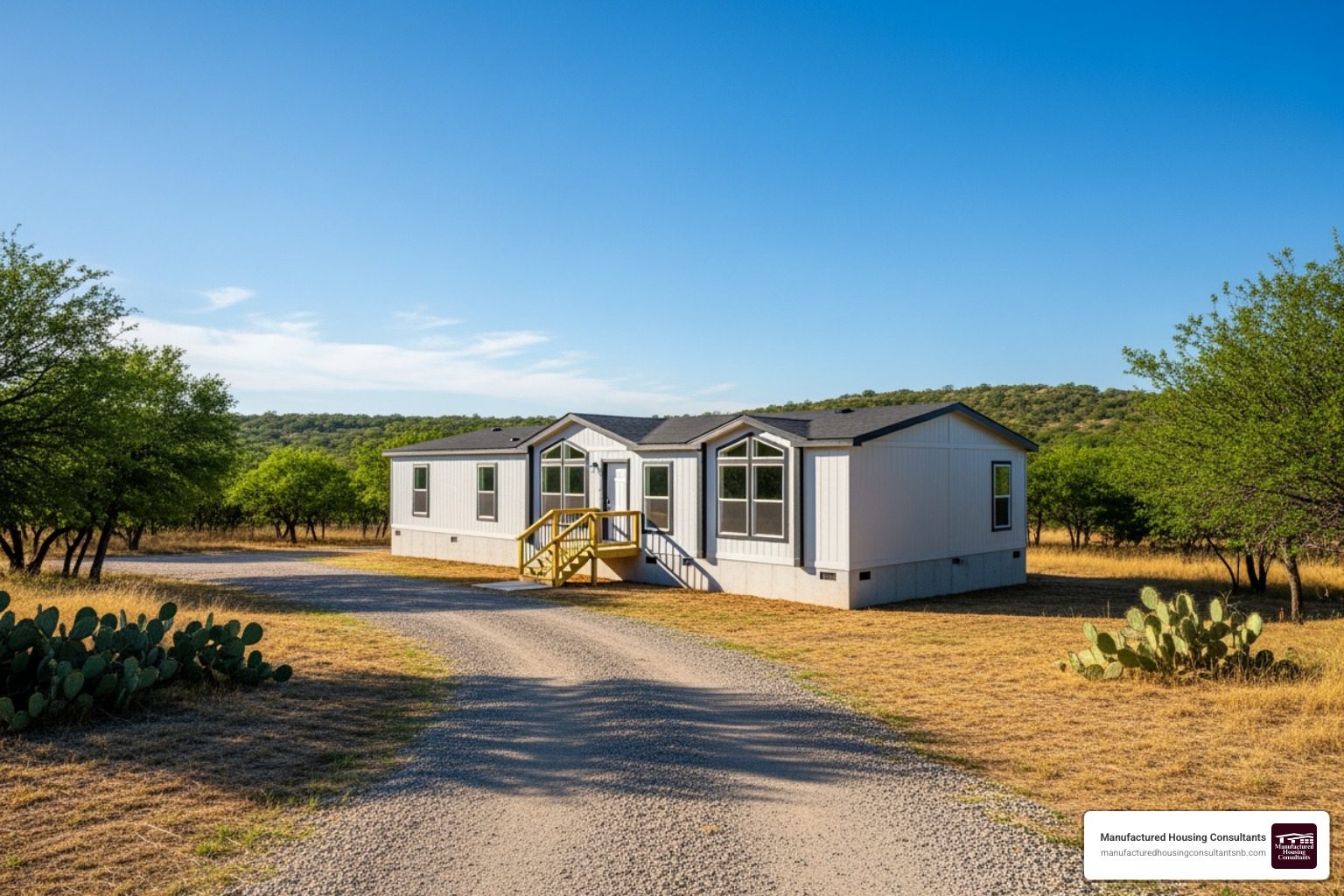Is Your Double Wide a “Real” House? The Foundation Factor Explained
Discover how putting a mobile home on a foundation transforms it into real property. Boost value, stability, and financing options.
Why Putting Your Mobile Home on a Foundation Changes Everything
Putting a mobile home on a foundation transforms it from personal property (like a car) into real property (like a traditional house). This single change open ups better financing, higher home value, and improved stability—especially for Texas homeowners facing our unique soil and weather.
Quick Answer: What You Need to Know
- Foundation Types: Slab ($4k-$9k), Pier & Beam ($1k-$2k), Crawl Space ($6k-$15k), Basement ($12k-$25k+)
- Installation Cost: Approx. $3,000 per section (Single-wide ~$3k, Double-wide $7k-$12k)
- Key Requirements: HUD compliance, engineer certification, removal of wheels/axles/tongue, proper anchoring
- Major Benefits: Qualifies for FHA/VA loans, increases property value, improves stability and safety
- Timeline: Foundation installation typically takes hours to days, not weeks.
A permanent foundation is the key to qualifying for a conventional mortgage with favorable rates, rather than a high-interest chattel loan. It allows your manufactured home to gain value over time.
At Manufactured Housing Consultants in New Braunfels, we guide Texas homeowners through this process daily. We understand local soil, TDHCA regulations, and how to convert your home into real property that builds wealth. The process is more straightforward and affordable than most people expect.

Putting a mobile home on a foundation helpful reading:
The Step-by-Step Process for Putting a Mobile Home on a Foundation
Putting a mobile home on a foundation is an achievable and rewarding journey. With the right guidance, you can secure your manufactured home and transform it into a permanent part of your Texas property. Here’s what you need to know.
Step 1: Choosing the Right Foundation Type
Your foundation choice is the bedrock of your investment. In Texas, it’s about balancing budget, land characteristics, and long-term goals.
- Pier and Beam Foundations: This affordable system ($1,000 – $2,000) uses piers to support the home, creating a crawl space for easy utility access. It’s great for sloped lots and expansive clay soils but requires skirting.
- Slab Foundations: A solid concrete platform ($4,000 – $9,000) poured on leveled ground. Slabs offer excellent durability and protection from moisture and pests, ideal for flat, stable lots. However, utility access is limited.
- Crawl Space Foundations: Similar to pier and beam but with an enclosed perimeter ($6,000 – $15,000), this option offers great utility access and a traditional look that boosts resale value. It requires proper ventilation to prevent moisture issues.
- Basement Foundations: The premium option ($12,000 – $25,000+), a full basement adds significant living space and value. It offers the best protection and energy efficiency but is the most expensive and not suitable for all soil types or water tables.
Before deciding, always get a professional soil test. For the expansive clay soils common in Central Texas, flexible systems like pier and beam or crawl space often outperform rigid slabs.
| Foundation Type | Average Cost (Installation) | Pros | Cons | Best For |
|---|---|---|---|---|
| Pier & Beam | $1,000 – $2,000 | Affordable, handles slopes well, easy utility access, good ventilation | May settle over time, requires skirting, lower resale appeal | Budget-conscious buyers, uneven lots, areas with expansive soils, anyone wanting easy utility access |
| Slab | $4,000 – $9,000 | Very stable, durable, excellent moisture/pest barrier, long lifespan | No utility access underneath, can crack with ground movement, not ideal for slopes | Flat, stable lots where moisture control matters and utility access isn’t a primary concern |
| Crawl Space | $6,000 – $15,000 | Excellent utility access, good insulation, traditional appearance, effective moisture protection | Higher cost, requires proper ventilation, needs maintenance to prevent moisture issues | Those wanting to balance accessibility, energy efficiency, and a permanent look—suitable for most Texas conditions |
| Basement | $12,000 – $25,000 | Maximum space, highest value, superior protection, best insulation and efficiency | Highest cost, longest installation, limited by soil type and water table | Homeowners seeking maximum space and value, where soil conditions allow |
Want to dive deeper into these options? Check out our detailed guide on Mobile Home Foundation Types for even more information specific to Texas conditions.
Step 2: Understanding the Costs of Putting a Mobile Home on a Foundation
While putting a mobile home on a foundation is a smart investment, it’s crucial to understand the full cost. The total price includes more than just the foundation itself.
Here’s a breakdown of typical expenses:
- Foundation Construction: As detailed in Step 1, costs range from $1,000 for a basic pier and beam to over $25,000 for a basement.
- Home Installation: Setting the home on the foundation costs approximately $3,000 per section. A single-wide is about $3,000, while a double-wide is typically $7,000 to $12,000. This includes moving, anchoring, and finishing the home.
- Labor & Materials: Specialized contractors in the New Braunfels area charge $50 to $150 per hour. Concrete and other materials can add $2,500 to $12,000+.
- Permits: Expect to pay $500 to $2,000 for local Texas permits, depending on your county or city.
- Site Preparation: Costs vary widely based on your land’s condition. This includes clearing, grading, soil testing, and preparing for utility connections.
Retrofitting an existing home with a HUD-compliant permanent foundation typically costs $15,000 to $30,000. Remember this investment open ups better financing, higher property value, and long-term savings.
Step 3: Navigating Texas Regulations and HUD Requirements
Getting the legal compliance right is critical. These regulations protect your investment and ensure you qualify for the best financing. At Manufactured Housing Consultants, we handle this complex process for our clients.

Key requirements for putting a mobile home on a foundation include:
- HUD Standards: The federal Permanent Foundations Guide for Manufactured Housing is the gold standard. It requires a site-built foundation of durable materials, engineered to handle all loads.
- Permanent Affixation: The home must be permanently attached to the foundation. Critically, the tongue, axles, and wheels must be removed to legally transition the home from “mobile” to “permanently affixed.”
- FHA/VA Loan Compliance: To qualify for these excellent loan programs, you need a professional engineer’s certification confirming your foundation meets all HUD standards. We guide clients through these requirements, which you can learn more about in our guide to VA loan rules for manufactured homes.
- State and Local Codes: The Texas Department of Housing and Community Affairs (TDHCA) adds state-specific rules. Your local city or county (like New Braunfels) has its own building codes for setbacks, utility connections, and foundation types. We have extensive experience navigating these local regulations.
An engineer’s certification ties it all together, giving lenders and you the confidence that your home is structurally sound and compliant.
Step 4: Site Preparation and Installation Essentials
Proper groundwork is critical for your foundation’s long-term stability. Cutting corners here can lead to expensive problems later.

Essential site prep and installation steps include:
- Clearing and Grading: The site must be cleared of all debris and graded to be level and sloped for proper water drainage away from the home.
- Soil Testing: Especially in Central Texas with its expansive clay, a geotechnical engineer must test the soil. This determines its load-bearing capacity and informs the foundation design, preventing future shifting and damage.
- Drainage and Water Management: The ground must slope away from the foundation. Solutions like French drains and vapor barriers (for crawl spaces) are often necessary to manage Texas’s heavy rains and prevent water damage.
- Utility Planning: Trenches for water, sewer/septic, and electrical lines must be planned and dug before the foundation is built. All utility work must meet code and be performed by licensed professionals.
- Foundation Construction: This involves pouring concrete footings and slabs or setting piers on footings, all according to the engineer’s specifications.
- Anchoring and Tie-Downs: This is a critical safety step. Steel straps connect the home’s frame to the foundation, securing it against wind uplift and shifting during severe Texas weather. The number and placement of tie-downs are specified by the engineer.
Step 5: How a Permanent Foundation Impacts Financing and Home Value
This is where putting a mobile home on a foundation becomes a financial game-changer. By converting your home from personal property to real property, you open up significant, long-lasting benefits.
- Access to Better Financing: You become eligible for conventional mortgages, including FHA and VA loans. This means lower interest rates, 30-year terms, and more manageable monthly payments compared to high-cost chattel loans. We specialize in helping buyers steer these options, which you can learn about on our Financing a Mobile Home page.
- Increased Home Value and Appreciation: A home on a permanent foundation is more valuable and has the potential to appreciate over time, just like a site-built house. It becomes a true real estate asset, not a depreciating vehicle.
- Lower Insurance Premiums: Insurance companies see permanently affixed homes as lower risk, especially against weather damage. This often results in lower homeowner’s insurance rates, saving you money every year.
This strategic decision secures your investment, expands your financing options, and transforms your manufactured home into an asset that builds wealth.
Step 6: Common Mistakes to Avoid When Putting a Mobile Home on a Foundation
Learning from others’ mistakes is far less expensive than making them yourself. Here are the most common pitfalls we help our clients avoid at Manufactured Housing Consultants.
- Ignoring Local Codes: Always check with your local Texas planning and building department before you start. What’s allowed in one county may be prohibited in another. Get all permits upfront.
- Improper Site Prep: A foundation is only as good as the ground beneath it. Don’t rush site clearing, grading, and compaction. Uneven settling leads to costly structural damage.
- Wrong Foundation for Soil: Don’t guess. A professional soil test is essential in Texas. Let the results guide your choice to prevent cracking or failure.
- Inadequate Anchoring: Your home must be securely tied down to the foundation to withstand high winds. This is a critical safety measure that must meet or exceed engineering and code requirements.
- Forgetting Crawl Space Ventilation: A poorly ventilated crawl space is a recipe for mold and pests. Ensure proper airflow and a vapor barrier.
- The DIY Temptation: Foundation work is not a DIY project. Improper installation can void warranties and lead to structural failure. Hire licensed, experienced contractors who specialize in manufactured homes.
- Neglecting Drainage: Ensure water flows away from your foundation. Proper grading and drainage systems prevent erosion and water damage over time.
Secure Your Investment and Build Your Dream Home

When you commit to putting a mobile home on a foundation, you transform it into a genuine real estate asset that builds wealth for your family. The key benefits are clear:
- Increased Market Value: Your home can now appreciate over time, a major advantage in the Texas real estate market.
- Improved Stability and Safety: A properly anchored foundation provides peace of mind, protecting your family and investment from Texas’s severe weather.
- Better Financing Options: You gain access to conventional, FHA, and VA mortgages with lower rates and better terms, saving you thousands.
- Full Regulatory Compliance: Meeting HUD and local codes ensures your home is safe, structurally sound, and ready for future sale or refinancing.
At Manufactured Housing Consultants in New Braunfels, we guide Texas families through this entire process. We understand local soil, TDHCA rules, and county codes. We’re not just selling homes; we’re building futures, one permanent foundation at a time.
We’re here for the whole journey, from helping you select a home to coordinating land improvements and foundation installation. Ready to take the next step? Explore Our Services to see how we can help, then View our available homes in New Braunfels and imagine your future.
Putting a mobile home on a foundation is a smart financial decision and the true start of homeownership. Let’s build that future together.


